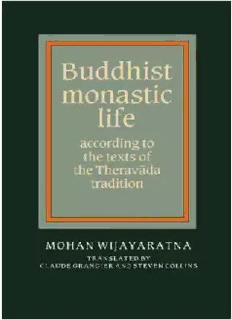
Buddhist Monastic Life: According to the Texts of the Theravāda PDF
Preview Buddhist Monastic Life: According to the Texts of the Theravāda
BUDDHIST MONASTIC LIFE BUDDHIST MONASTIC LIFE according to the texts of the Theravada tradition MOHAN WIJAYARATNA Translated by Claude Grangier and Steven Collins with an Introduction by Steven Collins The right of the University of Cambridge to print and sell all manner of books was granted by Henry VUl in 1534. The University has printed and published continuously since 1584. CAMBRIDGE UNIVERSITY PRESS Cambridge New York Port Chester Melbourne Sydney Published by the Press Syndicate of the University of Cambridge The Pitt Building, Trumpington Street, Cambridge CB2 1RP 40 West 20th Street, New York, NY 10011, USA 10 Stamford Road, Oakleigh, Melbourne 3166, Australia © Cambridge University Press 1990 First published 1990 Printed in the United States of America Library of Congress Cataloging-in-Publication Data Wijayaratna, Mohan. [Moine bouddhiste. English] Buddhist monastic life : according to the texts of the Theravada tradition / by Mohan Wijayaratna : translated by Claude Grangier and Steven Collins : with an introduction by Steven Collins. p. cm. Translation of: Le moine bouddhiste. Includes bibliographical references. ISBN 0-521-36428-0. - ISBN 0-521-36708-5 (pbk.) 1. Monasticism and religious orders, Buddhist. 2. Theravada Buddhism. I. Title. BQ6084.W5513 1990 294.3'657-dc20 90-33129 CIP British Library Cataloguing in Publication Data Wijayaratna, Mohan Buddhist monastic life. 1. Buddhist monasteries. Theravada Buddhist life I. Title II. Le Moine bouddhiste selon les textes du Theravada. English 294.3444 ISBN 0-521-36428-0 hardback ISBN 0-521-36708-5 paperback Contents Acknowledgments vii Introduction ix 1 The Origin of the Community 1 2 Dwelling Places 18 3 Clothing 32 4 Food 56 5 Money 76 6 Chastity 89 7 Solitude 109 8 The Rules of the Community 137 Conclusion 156 Appendix 1 Nuns 158 Appendix 2 Lay People 164 Appendix 3 The Precepts 181 Glossary 182 Index 188 Acknowledgments This book was originally published in French under the title Le Moine bouddhiste selon les textes du Theravdda (Editions du Cerf, Paris 1983). I am grateful to my friends Miss Marie- Therese Drouillon and Miss Brigitte Carrier who helped me to write it and Messrs. Bernard Lauret and Nicolas Zed who helped me to publish it. I am also grateful to the staff of the library of the College de France for their helpful and courte- ous service. In regard to this English edition, I wish to add a word of sincerest thanks to both translators who have done their work with utmost care, and to the Cambridge University Press for publishing it. Very specially I am thankful to Pro- fessor Steven Collins for his Introduction, Glossary and Index. I must take this opportunity of recording my deep sense of gratitude to Professor Richard Gombrich for the encourage- ment and inspiration he gave me from the beginning of the realisation of this English edition. Let us hope that this small book will be useful to the reader in Buddhist studies. Paris Mohan Wijayaratna 25 August 1989 Vll Introduction BUDDHIST MONASTICISM The monastic tradition of Buddhism is probably the oldest in the world, and has certainly been the most widespread, both geographically and culturally. The traditional dates for the Buddha given in Western scholarship are c.566-486 B.C.1: the order he founded has existed for two and a half thousand years. Although by the medieval period the Buddhist mon- astic order had all but disappeared from India, by that time it had been established in almost every other part of Asia. During the centuries following the Buddha's death various different "schools" of Buddhism arose; this book describes the ideal monastic life envisaged by one of them, the Thera- vada or "Way of the Elders."2 These ideals are preserved in the Pali canonical texts and commentaries and have been followed in India from the ancient to early medieval periods (a small modern presence remains in Bengal, and, by recent reintroduction, in Nepal); in Sri Lanka (formerly Ceylon) from the third century B.C.; and in mainland Southeast Asia (what are now Burma, Thailand, Laos and Cambodia) from medieval times until the present day. Alas, the twentieth century has not been kind to Buddhism: modern govern- ments in mainland China, Tibet, Vietnam, North Korea, Laos and Cambodia have attempted either to destroy the religion altogether or at least put very severe restrictions on the institutional possibilities for practicing it. As Dr. Wijayaratna explains in Chapter 1, the Buddha and IX
Description: